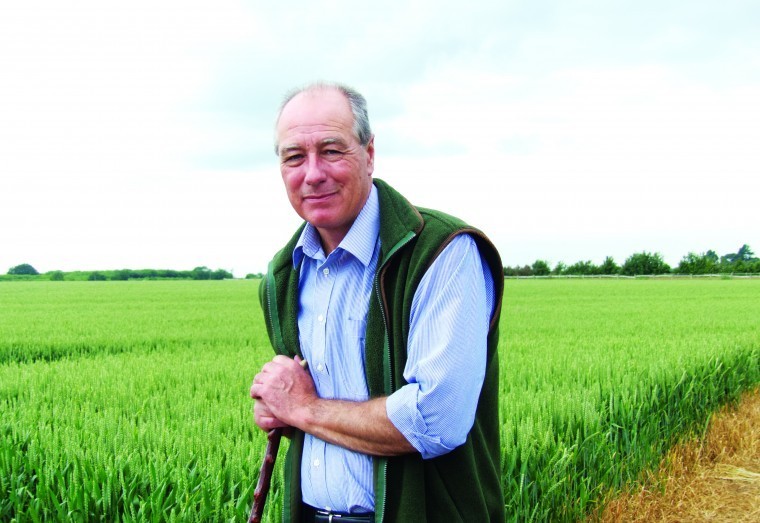March has seen some very warm days and some very cold easterly winds on this side of the country. Perhaps most importantly it has been dry and those winds have also dried soils to allow spring drilling, on lighter land at least, to get under way.
One should caveat that by saying that the wet February in Kent, with more than 3.5 inches of rain in the month, made absolutely sure that we started with not only very wet soil but also cold soil temperatures. Where we farm at the foot of the Wye Downs the spring line where chalk meets clay has springs rising in the middle of fields where they have not been seen for many years.
The existence of very old drainage systems indicates they used to run but water abstraction for urban areas had confined that situation into the distant memory. We have enjoyed many weeks of restoring old ditch systems and drainage pipes to working order but there are still very wet patches that we will simply drill round as they will not dry for weeks if not months. So yes we have drilled a substantial area of spring beans following up with pre emergence herbicides and Avadex on blackgrass areas after any showers that have moistened the soil surface to maximise efficacy.
With the herbicides we are back to higher water volumes and angled nozzles to get the best soil coverage we can – all aimed at increasing blackgrass control. We have several hundred acres of beans and barley still to drill and all of it on heavy land with severe resistant blackgrass problems. We have already sprayed blackgrass flushes off twice in the autumn and again this spring before moving the ground.
It is so wet underneath that we are faced with shallow discing twice to get some soil to dry on top so we can use a Simba Solo with low disturbance tines to work deeper without blocking discs and press. There is nothing like a challenge and at least with modern machinery we can work in spite of the soil conditions.
There are many good things to say about the condition of the growing crops. Oilseed rape is moving away with early sulphur nitrogen applications all completed in February or early March and having the desired effect. Even where there is pigeon damage – and there certainly was some of that in February, when the pigeons had completely gleaned the maize stubbles – the plants have good strong tap roots and central growing points which are responding to the nitrogen and longer day lengths. The earliest crops are already stem extending and need the rest of the nitrogen applied in short order. Grass weed control has been excellent with no signs of grass seedling emergence and crop competition rapidly shading out the soil surface.
Winter beans have come through the wet winter well, even on heavy Weald clay and are growing away strongly. Again weed control has been good, albeit at a price. Nirvana, Centium and Kerb Flo followed by Avadex is certainly belt and braces. There are however traces of blackgrass round the edges of clods which is a result of the rough seed bed that winter beans require. This is a real dilemma as heavy clay is such a challenge in the spring. But if we are not achieving the grass control we need from the autumn cropping option then it is questionable if that is the correct choice. Hopefully as the beans grow away the crop shading and competition will deal with what are very small seedlings.
Wheat crops fall into two camps in terms of growth: the very early drilled that grew away strongly tillered well and were too lush at Christmas and the later wet drillings where they have struggled badly. The cold dry weather has certainly held the strong crops back and they can very much be treated normally with nitrogen applications and T0’s fungicides at late March timings and no great issues to worry about.
To sum up they look well and should do well. The later ones have had early nitrogen applications and will receive chlormequat and manganese to promote tillering. They have also been ring rolled in the last few days to put our flints safely down out of the way and that also seems to encourage tillering and growth by consolidating the soil. They do not look well but with care and attention will produce viable crops and they do not have grass weed issues to worry about.
There are also two camps of grass weed control with the early drilled wheat. Where we were able to apply sequential herbicides pre and post emergence or follow up with Avadex then weed control is very good and spring contacts are really just tidying up. However where the weather and ground conditions prevented follow ups in the autumn, which is all the very heavy clay, then we have some challenges to deal with.
By the time next month comes round I will know whether they are challenges we are going to cope with or not. There is no doubt that on some of the heavy ground, while we have the machinery to cope with it physically, we clearly no longer have the tools to deal with the grass weeds. There may be a time approaching when the future of that land in arable cropping comes into question and perhaps the future for those farms is in photovoltaic panels or maize for anaerobic digestion plants.




